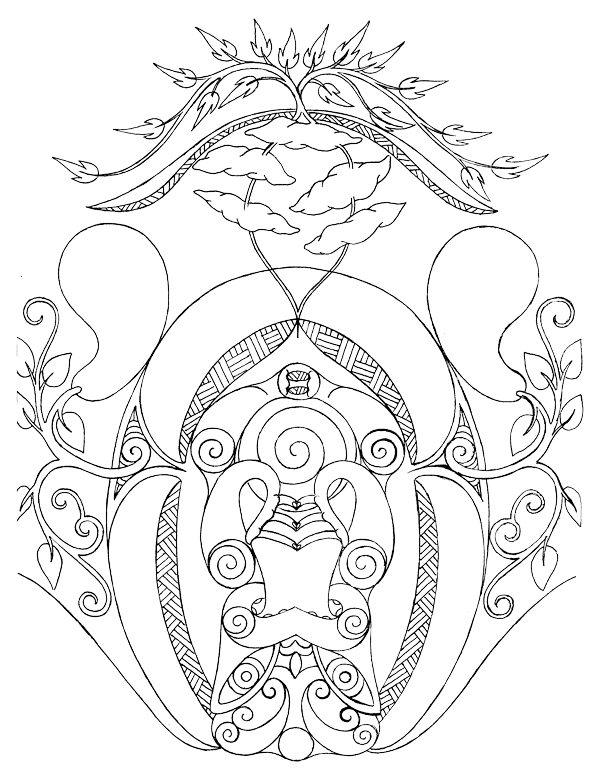
Rongomātāne
Playcentres are places where babies, young children and parents come together, grow together and develop a sense of belonging. Recently the whānau at Pinehaven Playcentre shared with the Enviroschools Network how they are engaging with the organic waste cycle and growing a stronger sense of how nature works in cycles. .
Ko Te Whānau Tupu Ngātahi tō hapori – Playcentre is your village
Since 2019, Pinehaven Playcentre has been working with Enviroschools to ensure their environment is a place tamariki can explore and experiment. They observe insects, the seasons and natural systems like the flow of water. They grow and cook food as part of their sessions and have developed systems to return organic waste to the earth.
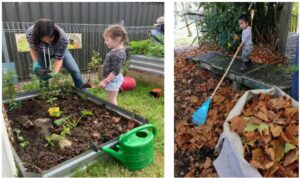
Katie plants courgettes and cherry tomatoes with Isabelle in the vegetable garden. Franco rakes leaves for the compost.
Identifying organic waste
In order to develop their organic waste systems, the centre began by identifying the organic waste they were generating and where it was coming from. They measured the daily amounts of a range of categories (eg. food waste) and extrapolated over a year. They knew roughly how many times a year they mowed and how many sacks of leaves they collected and came up with the following annual estimates:
- 200 kg food scraps – a mix of cooked foods and fruit and veges from lunches
- 100 kg weeds from gardens
- 50 kg twigs from fruit tree prunings
- 200+ kg lawn clippings, and
- 600+ kg leaves due to a magnificent sycamore
Establishing systems
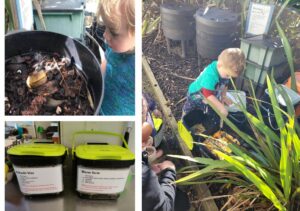
Tamariki get involved adding food scraps to the worm farms and bokashi. Buckets are clearly labelled to identify what goes into each system.
They then established daily systems that now mean they can deal with almost all their organics on-site. These include:
- worm farms to break down the food scraps generated each session,
- bokashi bins for cooked, citrus or oily foods,
- a large “lasagne” compost where they layer the huge number of sycamore leaves with the grass clippings, and bury the bokashi,
- a black bin for tricky customers like weeds and prunings that will take a long time and could infest gardens with their seeds.
These systems evolved as they noticed what worked for each kind of waste and researched the alternatives.
Each day after morning tea, tamariki transport the organic waste to the worm farms and bokashi bins.
“These are times for rich noticing and conversations with tamariki,” says Catherine Butler (parent and session supervisor).
One family shared how this regular routine inspired setting up their own family worm farm.
“Archie told his dad about the worm farm and what we do at playcentre with our food scraps, so now we have one!” – Christina Calcina
Feeding the community
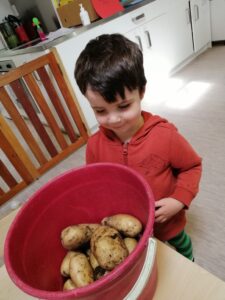
Proudly displaying potatoes harvested from the compost bin.
The tamariki replenish the soil in their vegetable gardens with compost as they plant new seedlings but the compost pile has also become a direct growing medium. In late 2021 they had a go at planting Giant Atlantic Pumpkin in their lasagne compost. To their delight, when they arrived back at playcentre after their summer break, they discovered one seedling had really flourished!
The paukena was so huge it took two adults to lift it. Tamariki cleaned it and cut it and methodically collected the seeds to dry and share for planting next Raumati.
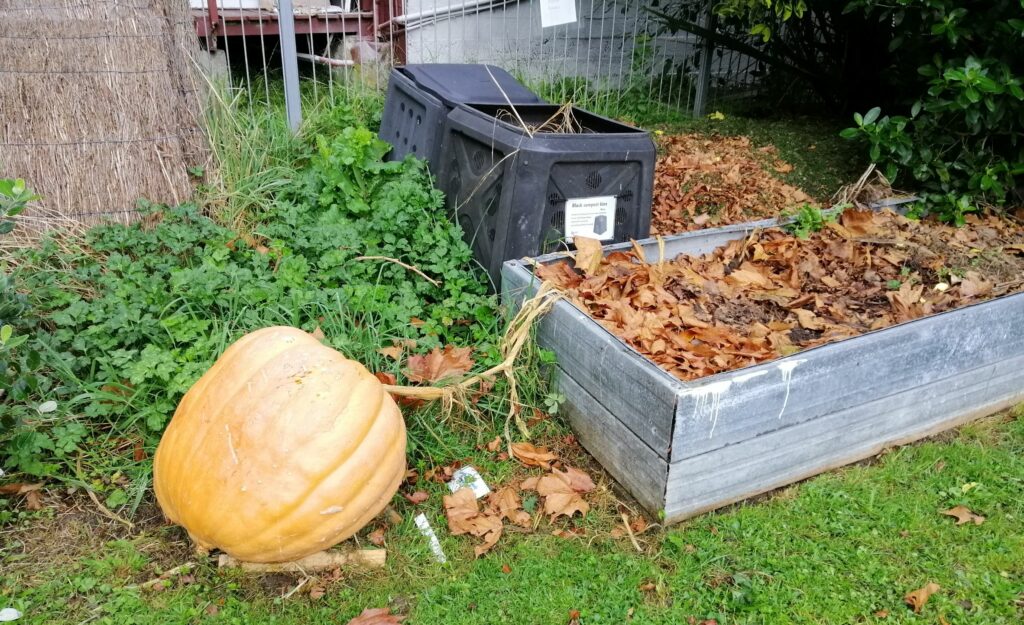
The enormous pumpkin that grew over summer in the compost bin and was shared with local Home of Compassion.
There were many ideas for what they could do with all this pumpkin. They used some for cooking at Playcentre and shared the rest with the Home of Compassion, to make soup for the elderly people who lived there.
Flow on effects
The awareness of these natural cycles around them has rippled through to other aspects of the playcentre.
They have adapted their play to more carefully use resources e.g. paperless painting on washable easels and making dye from beetroot to colour playdough. The centre no longer uses glitter.
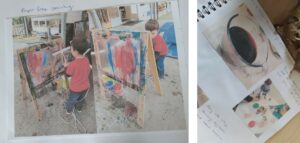
Paperless painting on washable easels and dye made from beetroot skins are two examples of how careful Pinehaven Playcentre are with their resources.
The centre has developed a commitment to repairing broken items and gradually replacing plastic items with those from more permanent materials that will last. They have held social dress swaps and were able to offer all families a My Cup menstrual cup or Love Luna period underwear with a grant from UHCC.
Tamariki are confidently involved in sustainable practices and take this knowledge with them when they move on to school, asking, “what happens to food scraps,” and “where is the compost?”
Sharing the Learning
In June 2022 two of the thoughtful and committed parents, Katie Bailey and Catherine Butler, ran an online workshop for the Enviroschools network, sharing the processes they have developed and how they have involved their tamariki.
The workshop also explored the role that appropriate disposal of green-waste can play in reducing carbon emissions. Six percent of Upper Hutt’s greenhouse gases comes from organic waste in landfill. Reducing organic waste to landfill is one way we can make an immediate difference.
Katie subsequently ran a face to face workshop for other teachers to unpack these systems at the Pinehaven Community Gardens and Playcentre.
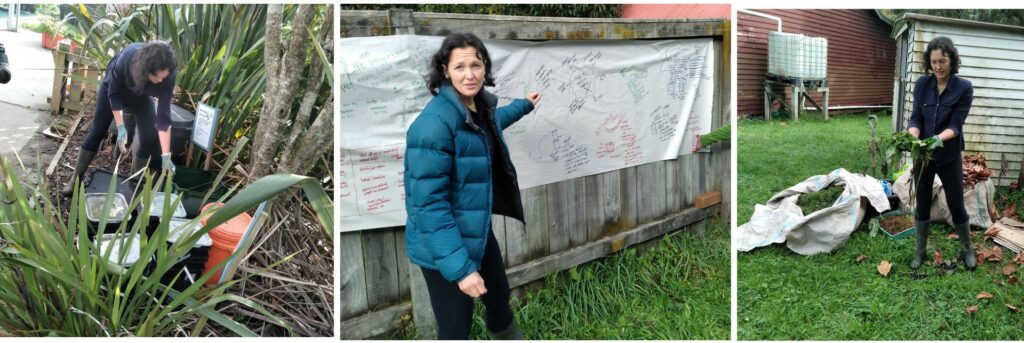
Pinehaven parent Katie Bailey explained the composting process and demonstrated how to effectively layer compost and use bokashi bins and worm farms.
As a result of this workshop, Mangaroa School has started the process of redesigning their composting systems to be more effective, while Marlborough St Childcare Centre has gained ideas about how to get started.
As a network, we can all grow together.